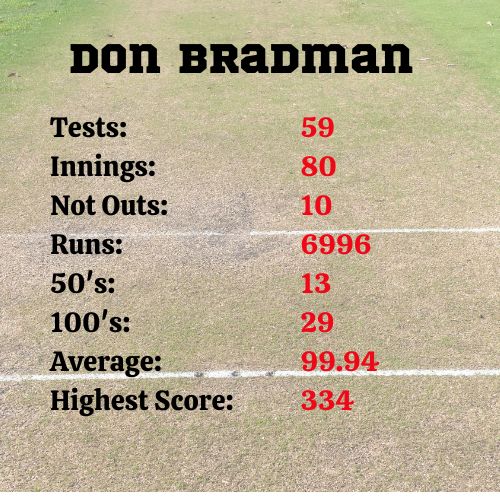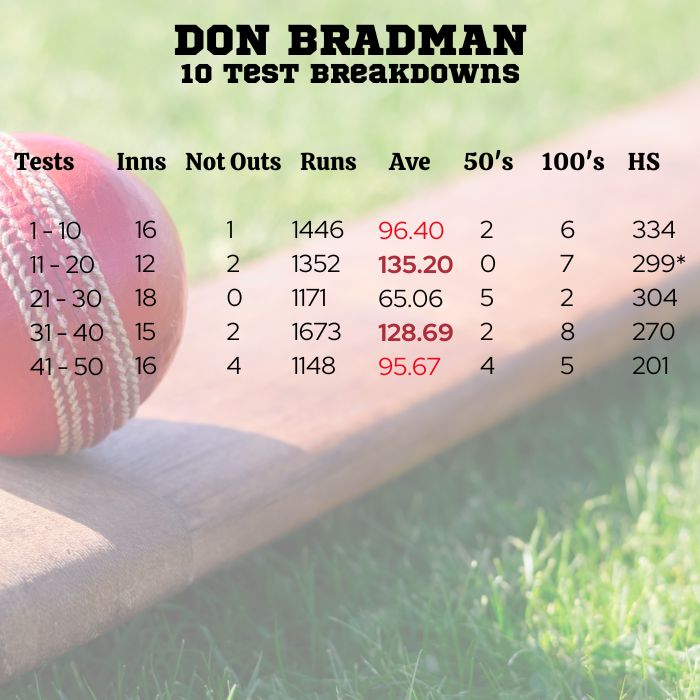In most sports, when fans ask ‘Who is the greatest to have ever played the game?’, you can get a lengthy, heated argument, possibly causing friendships to break and authorities to be called in with riot gear.
But not with cricket.
Because the answer is simple.

State Library of South Australia from Australia, CC BY 2.0, via Wikimedia Commons
It’s Don Bradman.
With daylight second. And possibly third, fourth and fifth as well.
Welcome to the first in a series of posts highlighting the greatest cricketers the world has ever seen.
Beginning, with the best.
Don Bradman’s Test Stats

The sheer magnitude of Bradman’s success is encapsulated in a single, staggering statistic – an average of 99.94 in Test cricket. This figure, a testament to his extraordinary consistency, remains the benchmark against which all other batsmen are measured. Achieved over the course of 52 Tests from 1928 to 1948, this average is a cricketing anomaly, often considered unattainable for contemporary players. To put that figure into comparison, as of the date of publishment of this post, the second highest average by any player who has played a minimum of 20 innings is 62.15, by England’s Harry Brook.
Don Bradman’s average is 37.8% better than second place. That is monumental.
So, let’s find out more about this great of the game.
Don Bradman’s Early Life
Don Bradman was born on the 27th August 1908 in a small town called Cootamundra, located in the South Western Slopes of the state of New South Wales, Australia. When he was about two and a half years old, his parents moved to Bowral.
It has become part of Australian folk lore the stories of how Don Bradman trained as a youth. Using a cricket stump for a bat and a golf ball, he would throw the ball against a brick stand on top of which was mounted a water tank, and then hit it with the stump as it bounced back at him. Due to the curved nature of the brick stand and the obvious inconsistencies in the brick surface itself, the ball would come back at unpredictable speed and angles, so to be able to hit the ball at all, much less with a stump, showed that young Don had remarkable hand-eye co-ordination. A skill that continued to increase as he continued to practice.
Don Bradman went from a bush cricketer to a grade cricketer for St George, to a New South Wales state cricketer to an Australian test cricketer in the space of two years. A meteoric rise.
Don Bradman’s Test Career … for the stats nerds.
Don Bradman’s first test was a record-maker, just not for the reasons Don Bradman, or Australia, might prefer to remember.
Playing England, Australia was set 742 to chase (yes, 742), and scored just 66. The victory, at 675 runs, was, and still is, the largest ever test victory. Don scored 18 and 1.
Things improved, of course. Bradman’s average topped 100 for the first time in his 15th test innings, which included his 6th test century. From that point on, it would only dip once below 90; after his 39th innings, where it dipped to 89.55.
Don Bradman also had a habit of converting 50’s to 100’s. It is every batter’s dream to score 100’s and every half-century that doesn’t convert to a century seems a wasted effort. But even so, even the very best batsmen rarely have more centuries than half-centuries. Sachin Tendulkar has 68 half-centuries compared to 51 centuries; Virat Kohli has (as of the publish date of this post) 30 half-centuries compared to 29 centuries). Bradman’s record of having just 13 half-centuries compared to 29 centuries is extraordinary.
In fact, after scoring his second half-century, Don Bradman wouldn’t record another score between 50 and 100 for 24 innings, during which time he scored 12 centuries.

Every batter who has ever played the game has had their form slips. Even Don Bradman. During a ten innings period, which included the infamous Bodyline series, Bradman averaged only 39.6. Now, I say ‘only’, because compared to his normal average it is a big difference. But there have been many a good batter who didn’t average 39.6 for their entire career.
And his best ten innings? Well, there happened to have been a World War in the middle of them. For 8 years, people couldn’t rely on Don Bradman scoring runs to keep their morale up. But when the war was over, Bradman returned, and his first two innings following showed he hadn’t lost his ability as he scored 187 and 234, to round out his best 10 innings period with an average of 154.5, and 7 centuries.
Important Innings and Moments
1930: 334 v England at Headlingley
One of Bradman’s most iconic innings came at Headingley in 1930 when he scored a breathtaking 334. At the time, this was the highest individual test score. On the first day of the test, he scored a century before lunch, a century between lunch and tea, and finished the day with 309 runs. This is the first and only time a batter has scored more than 300 runs in a day.
A stat that is particularly amazing is that he didn’t hit a single six in this innings, and in fact, Don Bradman only hit six 6’s in his entire test career. He kept the ball on the ground, theorizing that you can’t get caught if you don’t hit in the air.
Not that Bradman couldn’t hit sixes if he wanted to. In a second-class game he once scored 100 runs off 22 balls, finishing with 256, during which he hit 14 sixes … more in one innings than he hit in his entire career.
1932/33: v England – Known as the ‘Bodyline Series’.
Bodyline was a bowling strategy employed by the English cricket team during the 1932/33 Ashes series held in Australia to contain and restrain the batting exploits of Don Bradman. In an earlier test match innings, it was noticed that Bradman struggled against a particular type of short-pitch at-the-body bowling, and so an entire strategy was devised to target that one slight weakness.
And guess what … it actually worked.
The strategy was to continuously bowled very fast and very short, right at the batter’s body, with numerous fielders placed on the leg side. Eventually, the theory went, the batter would become frustrated at having to duck every ball and so would play at them, or attack them, and pop up catches to fielders placed in just the right positions.
England ended up winning the 5 test series 4-1, and Bradman’s average of 56.5, while still being a very good average for mortal cricketers, was nowhere near his normal average.
Following the tour, the laws were changed to lessen the number of fielders allowed to field on the leg side behind the square leg line, as the Bodyline strategy was deemed too dangerous for cricket.
1948: The ‘Invincible’ tour and Don Bradman’s last innings
Don Bradman’s test career swansong culminated in what became known as the ‘Invincible’ tour. Touring England, Australia went through the entire tour – which, during those times, consisted of not just test matches but a good number of matches against county sides – entirely undefeated.
Bradman started in his customary way by scoring 138 in the first innings of the first test at Nottingham, and then dealt a bit of foreshadowing with his second innings duck. Scores of 38 and 89 in the second test were followed by 7 and 30 not out in the third test, and 33 in the first innings of the fourth test.
In the second innings, Australia was tasked with requiring 404 runs to win, at that time a total that had never been chased down in the 4th innings of a match before.
But, thanks to an unbeaten 173 by Don Bradman, and a partnership of 301 with Arthur Morris (who scored 182), Australia chased down the mammoth total having lost only 3 wickets.
Thus we come to Don Bradman’s last test.
At this stage, Bradman averaged 101.39, and after England scored only 52 in their first innings, most people likely expected that Bradman would only bat once. If that was the case, he needed just 4 runs to take him to 7000 runs and thereby ensure he finished his career with an average of at least 100.
But a man named William Hollies, a leg spinner, would ruin that for all Australians.
After being given a rousing reception by the crowd and three cheers by the English team, people would later say that Don Bradman had a tear in his eye when he faced up to Hollies. This was unlikely, but whatever the case, the second ball spun past Bradman’s defensive prod and hit the stumps.
Don Bradman was out for a duck. His average dipped to 99.94.
Technically, Bradman still had a chance of passing that 100 average. He just needed to score at least 104 in the second innings.
But once again the English didn’t play their parts well enough. First, they let Australia score 389 and lead on the first innings by 347. Then they collapsed once again in the second innings and scored only 188, losing by an innings and not allowing Don Bradman this final farewell.
And yet, isn’t there something about being so close to such a magical figure but not reaching it that increases Don Bradman’s legend even more so?
What can we learn from Don Bradman? And a final Conclusion.
I never saw Don Bradman play cricket. My cricket watching days began nearly 4 decades after he finished. And the video I’ve seen of him bat is not exactly 4K quality. But there are a couple of things I’ve come to think about Don Bradman; things that people who are now learning the game could do well learning and understanding.
Don Bradman was unconventional. Look at the video above. I look at some of the shots he makes and they don’t seem to come out of any textbooks I’ve ever seen.
But he made it work.
And if you are someone just coming up in the game, learning how to hit this kind of shot, or bowl this type of ball, know this: you don’t have to be textbook perfect to be very effective in this game. There are many textbook perfect batsmen who go nowhere.
Find out what’s right for you. Work with your coaches, yes, listen to them, but find out what works well for you. If you are a batsman, don’t try to be the next Sachin Tendulkar, or Ricky Ponting, or this generation’s Don Bradman.
Be you. Find out what that means, and the be the best you possible.
Maybe that means your batting doesn’t look perfect. Maybe your stance is wonky, you fidget a lot as you face the ball, maybe this, maybe that, maybe whatever. That’s ok. Talk to your coaches, see what you can work out, but also have some faith in yourself and know that perfection is not required to be the best you can be.
And maybe that’s why its good that Don Bradman didn’t average 100. Maybe it’s good to know that even someone as great as the Don wasn’t perfect.
He was just the best him he could be.
Do you have any Don Bradman stories you want to relive and have a conversation about? Leave your thoughts and comments below.
And come back for our next post in the series of Cricket Legends, when we’ll talk about Sachin Tendulkar.

